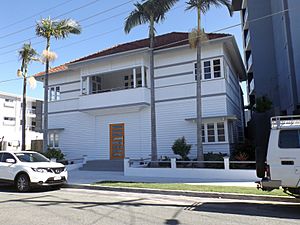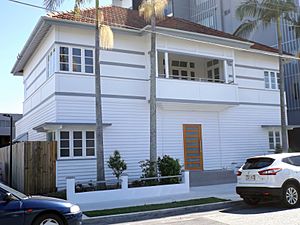Nundah Fire Station facts for kids
Quick facts for kids Nundah Fire Station |
|
|---|---|

Building in 2015
|
|
| Location | 7 Union Street, Nundah, City of Brisbane, Queensland, Australia |
| Design period | 1919 - 1930s (interwar period) |
| Built | 1936 |
| Architect | Atkinson & Conrad |
| Official name: Nundah Fire Station (former) | |
| Type | state heritage (built) |
| Designated | 26 March 1999 |
| Reference no. | 602119 |
| Significant period | 1936 (fabric) 1936-1999 (historical) |
| Significant components | engine room / appliance bay (fire station), watch room, residential accommodation - superintendent's house/quarters, driveway, dormitory, shed/s, pathway/walkway |
| Builders | T F Woollam |
| Lua error in Module:Location_map at line 420: attempt to index field 'wikibase' (a nil value). | |
The Nundah Fire Station is a historic building located at 7 Union Street, Nundah, City of Brisbane, Queensland, Australia. It used to be a fire station. This building was designed by the architects Atkinson & Conrad and built in 1936 by T F Woollam. It was added to the Queensland Heritage Register on March 26, 1999, because of its special historical importance.
Contents
A Brief History of Fire Services
For a long time, it was hard to create a good fire fighting service in Brisbane. Between 1860 and 1868, there were five attempts to start a fire brigade. These early groups struggled because they didn't have enough money, proper equipment, or a reliable water supply. City leaders didn't see fire services as a top priority back then.
Building a Stronger Fire Brigade
In 1868, a new group called the City Volunteer Fire Brigade was formed. This time, new rules helped manage money better. A Fire Brigade Board was created with members from the Brisbane Municipal Council and insurance companies. These rules became official with the Fire Brigades Act of 1881.
Money for fire services came from the Queensland Government, the Brisbane Municipal Council, insurance companies, and public donations. In 1889, Brisbane hired its first full-time firefighters, creating a permanent fire brigade. A new main fire station was built in 1890, designed by Henry Wallace Atkinson. This started a long connection between the Fire Brigade and Atkinson's architectural firms.
Nundah's Own Fire Brigade
As Brisbane grew, more fire services were needed in the suburbs. The Fire Brigades Act Amendment Act of 1902 allowed local areas to set up their own fire brigades. The Nundah Fire Brigade was started by local volunteers in 1916. Other suburbs like Hamilton and Wynnum also formed their own brigades around this time. These were mostly volunteer groups, with only the superintendent and a few assistants getting paid.
In 1920, the Fire Brigades Act changed again. It brought all the fire brigades in Brisbane and its suburbs under one main control group called the Metropolitan Fire Brigades Board in 1921.
The New Nundah Fire Station
The Nundah Fire Brigade first stored its equipment at the Royal Hotel. Then, in 1917, a small shed and a bell tower were built on Union Street. This shed served as the Nundah Fire Station until 1936.
In the 1930s, the Queensland Government decided to upgrade fire services. They funded new fire stations and replaced old ones. As part of this plan, the old Nundah fire shed was taken down. A new, two-storey station was built specifically for fire fighting. It was designed by HW Atkinson and AH Conrad, and built by TF Woollam. The new station officially opened on December 11, 1936. Other new stations were built in areas like Coorparoo and Wynnum around the same time.
The new Nundah Fire Station had the fire fighting equipment and offices on the ground floor. The first floor was a home for the superintendent, who was the head of the station. This design, combining the station and a residence, was common for fire stations back then.
In 1990, the Metropolitan Fire Brigade became part of the Bureau of Emergency Services. The Nundah Fire Station stopped being used as a fire station in 1999. Fire operations moved to a new station in Hendra. The old Nundah Fire Station was later changed into two apartments, one on each floor.
What the Station Looks Like
The Nundah Fire Station is a two-storey building made of timber. It has a balanced, even look. It's located at the north end of Union Street, close to the railway line. The top floor is covered with a material called fibrous cement sheeting, and the bottom floor has timber weatherboards. The roof is made of terracotta tiles and slopes down on all sides (a hip roof).
On the first floor, there's an open balcony in the middle that sticks out over the entrance to the engine room. The words "Nundah Fire Station" are painted in red on the lower part of this balcony. The dark horizontal lines against the white walls on the top floor make the building stand out on the street.
Inside the Station
The ground floor of the building used to hold the main parts of the fire station. This included the engine room where the fire trucks were kept, a watch office, a locker room, and a dormitory where firefighters could rest. There was also a kitchen, laundry, and a bedroom for the duty officer.
A special timber pole used to connect the residence upstairs to the engine room below, allowing firefighters to slide down quickly. This pole has since been removed. The locker room still has the original lockers where firefighters kept their uniforms and personal items. The concrete floor in the engine room still shows red marks from the fire truck wheels.
The inside walls are covered with timber boards, and the ceilings are also boarded. A brass plaque on the engine room wall remembers the station's opening. The original timber stairs at the back have been replaced with metal ones. Windows on the ground floor have timber shades, and some have added aluminum screens.
The Superintendent's Home
The first floor was the superintendent's home. It had a kitchen, living room, dining room, three bedrooms, and an open balcony. The living room, dining room, and main bedroom all have French doors that open onto the balcony. These doors have glass panels above them (fanlights) and sometimes on the sides (side lights). The space where the fire pole used to be is now a cupboard.
The inside walls and ceilings of the residence are also covered with timber boards. The kitchen cupboards, linen cupboard, dining room cupboard, and main bedroom wardrobe are still there. The bathroom floor is made of terrazzo, a type of mosaic flooring.
The Grounds
The area around the fire station is well-kept with grass and concrete paths. A concrete path leads from a gate to the back stairs of the residence. A concrete driveway on the south side leads to an area for drying hoses and a shed behind the station. There are also newly planted palm trees around the building.
Why It's a Heritage Site
The Nundah Fire Station (former) was added to the Queensland Heritage Register on March 26, 1999, for several important reasons:
- Shows Queensland's History: This building is a great example of how fire stations were upgraded in Brisbane's suburbs by the Queensland Government in the 1930s. It was used as a fire station for a long time, from 1936 to 1999.
- Shows a Special Design Style: The Nundah Fire Station is a good example of the work of the architectural firm Atkinson and Conrad. It's also a clear example of how Brisbane suburban fire stations were designed and planned in the 1930s, with offices and the engine room downstairs and a home upstairs. The inside parts, both for the fire station and the home, are still mostly original and show how fire stations worked back then. The kitchen is a particularly good example of an original home interior.
- Looks Good and Is Important for Its Design: The Nundah Fire Station, along with its surrounding area, has a special look and architectural importance. It's a simple, practical public building. Its strong, plain design, with striking horizontal lines and common building materials, makes it easy to spot in the neighborhood.
- Strong Community Connection: The Nundah Fire Station is important because the Fire Brigade has had a long connection with the Nundah community. Local volunteers started fire fighting services in the area in 1916.
- Connected to Important People: The architect Atkinson, through his different firms, had a long connection with Fire Services in Brisbane. This started in 1890 when he designed the main headquarters for the Brisbane Fire Brigade. His architectural practices were responsible for designing many fire stations across Brisbane.


